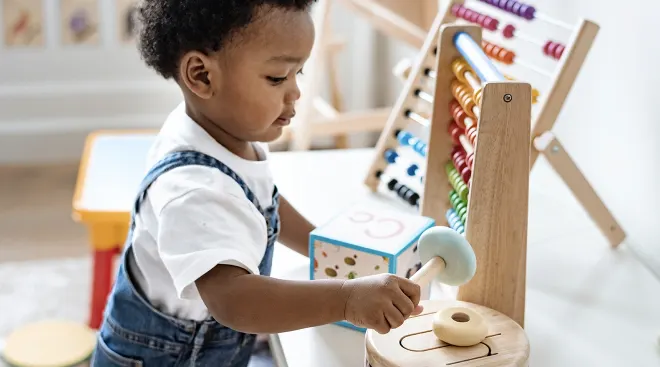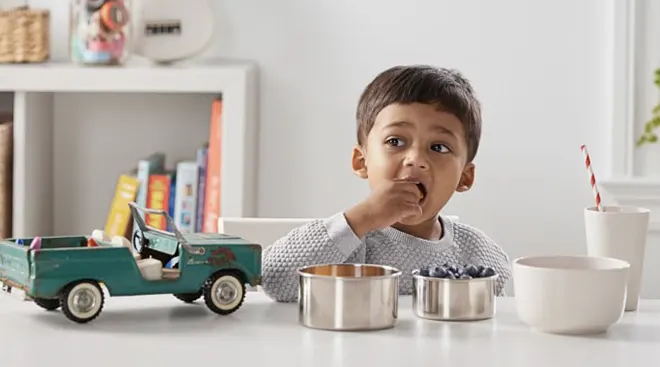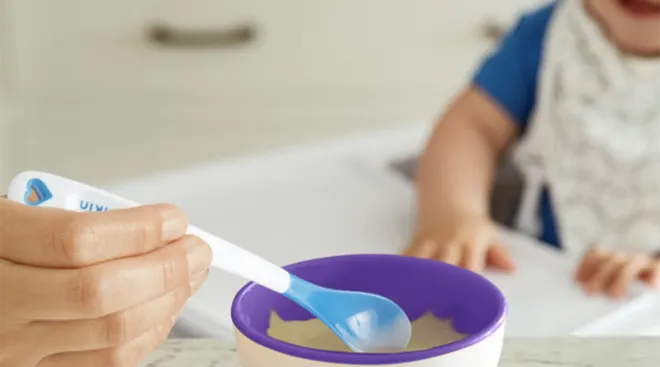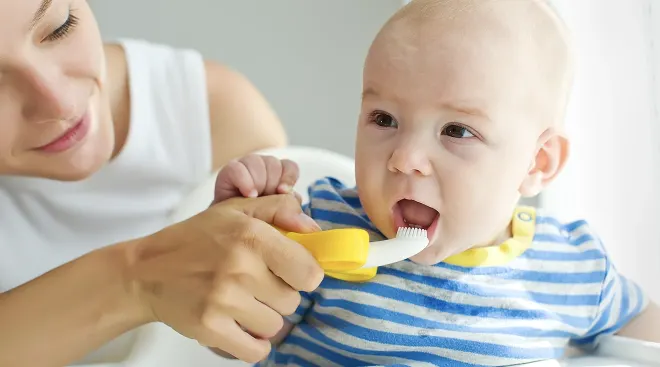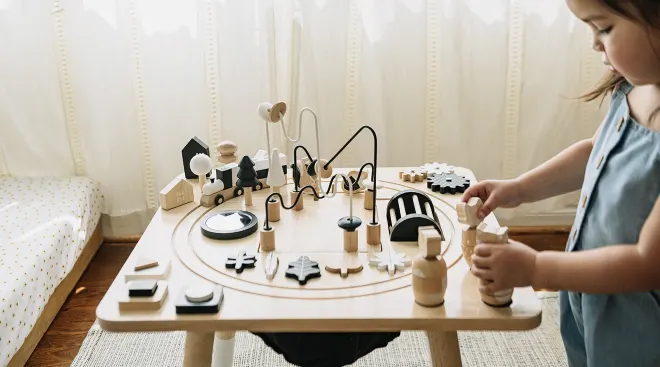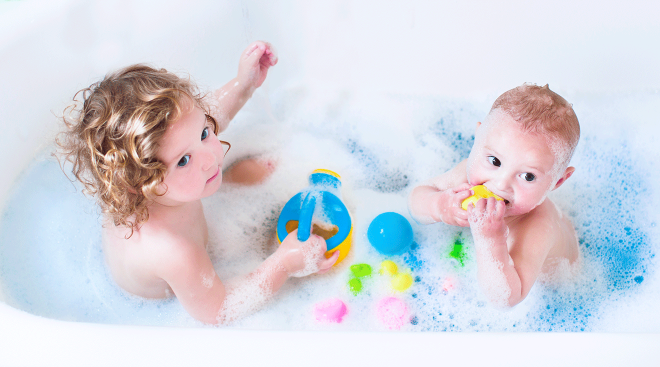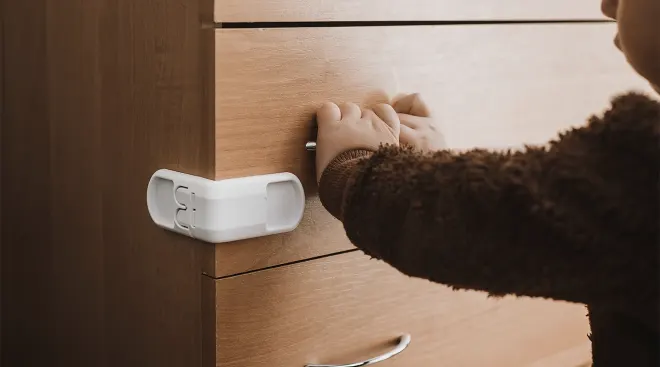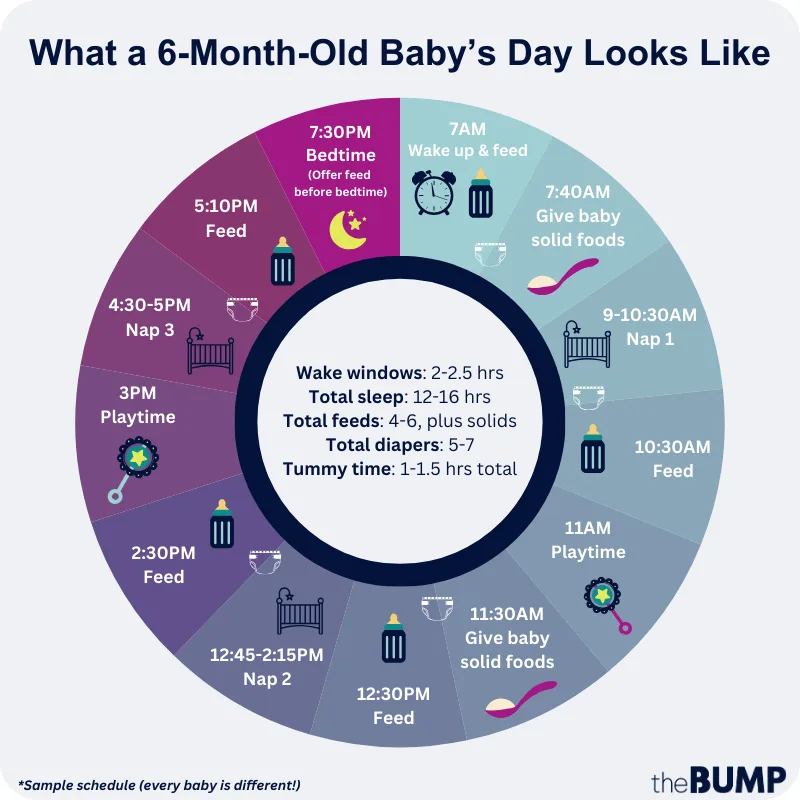6-Month-Old Baby

Can you believe you’re halfway through baby’s first year?! By the six-month mark, baby’s probably pretty opinionated. (Like, they might scream when anyone other than you holds them.) Baby’s also starting to develop food likes and dislikes as you introduce them to solids. Plus, they might be starting to sit up, which is super awesome. Another fun development? Baby might be starting to recognize their name—and show excitement when you say it.
Nothing is more thrilling than watching your 6-month-old baby learn and grow, but chances are you still have some questions surrounding this stage. Is your little one hitting the appropriate 6-month-old baby milestones? And what exactly do 6-month-old babies understand? Ready to learn more about their development, plus see a 6-month-old sleep schedule and basic routine? We’ve got you covered; read on for the full 411.
- It’s normal for baby to start teething around 6 months old. Common signs of teething include drooling, fussiness and swollen gums.
- Baby’s likely ready to start solids this month, if they haven’t yet! Whether you’re beginning with pureed fruits and veggies or baby-led weaning, go slowly and follow baby’s cues. Remember, breast milk or formula should still be their primary source of nutrition at this age.
- Baby is probably working on sitting up—they’ll be on the move soon!
If you’re wondering about the average weight of a 6-month-old, it’s around 16.5 pounds for girls and 17.5 pounds for boys. Average length (aka height) is 25.9 inches for girls and 26.6 inches for boys. Average or “normal” weight for a 6-month-old baby doesn’t tell the whole story though. Babies, like adults, have different body types, and just because baby doesn’t fall near the 50th percentile doesn’t mean they aren’t healthy. Instead, look at their rate of growth—your pediatrician will plot it on a growth chart. As long as baby continues on the expected upward swing, things are A-OK.
You might notice your 6-month-old going through a growth spurt, putting on about a pound this past month and more than a half a pound next month. During growth spurts, babies tend to act a little differently than their norm, perhaps wanting to feed more often or being a teeny bit cranky. Luckily, a growth spurt usually only lasts a few days.
Baby is a little person with plenty of personality and loads of curiosity at this point—and there are lots of exciting 6-month-old baby milestones happening. You’re likely to start seeing the following:
- Baby may have already started babbling vowel sounds, but now they may be working some consonants in there too. About half of 6-month-olds will repeat the same consonant sound over and over: “dadadada,” “babababa,” “mamamama” and the like. You may also be surprised and delighted by all the squeals and raspberry sounds they’re making now!
- They’re probably also laughing and giggling up a storm.
- Baby likely rolls in both directions: back to front and front to back.
- Baby “rakes” or picks up small objects by pushing them with their hand toward themselves.
- Baby sits up or tripods—but probably with some help. They’ll get there soon.
- They may soon start to pass objects from one hand to the other.
- What do 6-month-old babies understand? This is an exciting time, and most babies this age start grasping the meanings of certain words. They love hearing their own name; say it often and watch them respond with pure delight.
6-month-old sensory development
- Baby’s depth perception is still improving. They can look across the room at you and at their blocks on the floor.
- Six-month-old babies are also looking at things more closely. You probably notice their fascination in examining toys. (They might also put them in their mouth—this is totally normal!)
- Most 6-month-olds turn their head quickly when they hear something. Male and female adult voices may start to sound different to them.
- Baby’s interested in touching different textures and shapes and is even starting to touch their own body to get to know how it feels all over.
“When baby is born prematurely, it’s important that parents adjust their expectations around achieving developmental milestones by using their baby’s corrected age rather than their actual or chronological age. To calculate this age, take baby’s age in weeks and subtract the number of weeks they were born premature. For example, a 6-month-old (24 weeks) baby who was born 12 weeks early has a corrected age of 12 weeks or 3 months. Using the corrected age is a more accurate way for parents to gauge their infant’s development, as it accounts for the time baby would have continued growing and developing in the womb.” — Kushal Bhakta, MD, neonatologist and medical director of the NICU at Children’s Hospital of Orange County in Southern California
Baby’s firmly out of the newborn stage, but you’re likely still full of questions about their health. Here are some common topics parents want to know about at this age:
Flu shot
Once baby is 6 months old, they should get a flu shot, according to the Centers for Disease Control and Prevention (CDC). Along with reducing the chances that baby will get sick, the vaccine is designed to lessen their symptoms if they do come down with the virus.
Teething solutions
It’s common for babies to start teething around this age. If baby has been crying more than usual, is having trouble sleeping or has been drooling and perhaps has swollen gums, you may have a teething 6-month-old on your hands. Although your little one might be in pain, the CDC advises against using numbing gels. Instead, rub their gums with clean fingers, or give them something to chew on that’s not a choking hazard, like a firm teething toy or cold rag. You can also give them Tylenol as needed.
Tummy issues
At 6 months old, it’s likely baby’s starting solids. It’s an exciting (and messy!) milestone, but constipation, acid reflux and other stomach issues can come up. To help relieve discomfort, continue to give them plenty of formula or breast milk. Plus, make sure their new diet includes fiber-rich foods, like pureed prunes, pears, peaches and lentils. If constipation lasts more than a week or their poop has blood in it, call your pediatrician.
Sunscreen for baby
To protect baby’s skin, try to keep them out of the sun. But for times when they’re out and about, dress them in sun-protective clothing and accessories, like a wide-brimmed hat and sunglasses with UV protection. Then, apply a small amount of baby sunscreen to any exposed skin. Look for broad-spectrum, water-resistant, mineral-based products with an SPF of 30 or higher. Reapply every couple of hours and right after they come out of a pool or ocean.
Six-month checkup and vaccines
Along with measuring and weighing baby and performing a physical exam, your pediatrician will likely do a dental health check at this visit. Plus, at this appointment, your little one should receive their third doses of vaccines (including Rotavirus, DTaP, Hib, PCV, IPV and HBV). At 6 months old, they can also get their first flu shot and COVID-19 shot.
All of a sudden, there’s more than milk on the menu! Here’s what you need to know as baby’s feeding repertoire expands to include solid foods.
How much should a 6-month-old eat?
If you’re just now introducing solids, go slowly and follow baby’s cues. Six-month-olds don’t really need a lot of food at this point; it’s more about introducing the concept of solids. In terms of a 6-month-old feeding schedule, you might start out with 1 ounce of baby food at a meal and gradually increase the amount to about 3 ounces, three times a day, if it seems like baby’s enjoying it. The longer baby’s been eating solids and the more they’re interested in eating them, the more you should feel free to offer.
However, milk should still be the main part of baby’s diet. Here are some basic guidelines for how much formula or breast milk to give:
- Breastfeeding: How often should a 6-month-old nurse? You’re still typically breastfeeding every three or four hours, but each breastfed baby is different (and their feeding schedule may change as you introduce solids). What’s important is that baby seems content, your boobs feel like they’ve been emptied (they’re soft) and baby’s gaining weight healthily.
- Bottle-feeding: How much formula for a 6-month-old? Typically 6 to 8 ounces about six times a day.
- Pumping: If you’re pumping breast milk, you’re probably wondering how many ounces is enough. Typically, baby needs about 25 ounces of breast milk per day. You’ll need to divide that by how many feedings baby typically has: So if you feed baby about six times per day, they should get about 4 to 5 ounces of breast milk at each feeding.
What can baby eat this month?
Six-month-olds are just starting to explore the wonderful world of solids! Start out with pureed fruits, veggies or whole-grain cereal, such as oatmeal. You should also gradually start introducing allergens and seeing how baby reacts. (Tell your doctor if you suspect an allergic reaction.)
Wondering what to feed a 6-month-old baby? These foods are excellent choices for baby’s first foods:
- Banana
- Avocado
- Sweet potato
- Brown rice cereal
- Oatmeal baby cereal
- Pear
- Butternut squash
- Acorn squash
You can also try giving baby finger foods. In fact, many parents like to try baby-led weaning, which fosters independence and encourages baby to self-feed (with supervision) rather than rely on you to spoon-feed them.
The following are some tasty finger foods that baby might enjoy. Always offer small, bite-size pieces they can safely chew (or, rather, gum) and digest:
- Steamed veggies, such as broccoli, potatoes and green beans
- Finely chopped strawberries, soft peaches and ultra-ripe pears
- Scrambled eggs
- Small pieces of soft cheese
- Soft easy-to-grasp foods, such as a sweet potato pieces
What foods should a 6-month-old not eat?
Wondering what foods to avoid feeding a 6-month old baby? The following foods can be harmful to baby:
- Raw honey. Baby can’t have honey until they’re one year old. There’s a risk of infant botulism.
- Cow’s milk. Stick to breast milk and/or formula for now. Cow’s milk can wait until baby turns one. In the meantime, they can enjoy yogurt and cheese!
- Raw meat, fish and eggs, and unpasteurized dairy products
Foods should be low in salt and sugar, but don't be afraid to add a favorite spice!
Can a 6-month-old have water?
Curious if your little one can have water at 6 months old? Yes, you can introduce water this month! Just don’t overdo it—baby can get full by drinking water, which means they’ll be missing out on the nutrients they need from breast milk, formula and/or solid food. How much water can a 6-month-old have? You can start by offering 4 to 8 ounces of water per day —as long as baby is still getting enough formula (up to 32 ounces per day) or breast milk (around five to eight feedings per day).
You may think you’re out of the night-waking woods now that the 4-month sleep regression is behind you. But unfortunately, at 6 months old, sleep can still be dicey. Lots of things could cause a 6-month-old sleep regression: For starters, baby might start waking in the middle of the night because of illness or teething pain. During a growth spurt, they might be extra hungry and want to feed more. Plus, now that they’re learning how to roll, creep and crawl, they might wake to practice their new skills in the middle of the night. Or, they might just miss their parents and want some cuddle time!
It’s all normal. (Exhausting, but normal.) If you’re wondering about the nitty-gritty of your 6-month-old’s sleep, read on.
6-month-old sleep schedule
It’s common to wonder: How much (or how many hours of) sleep does a 6-month-old need? On average, most babies this age sleep around 14 to 15 hours per day. About 10 or 11 of those hours may come at night, and the rest (three to four hours) come during the day. Some 6-month-old babies have dropped their third nap and are only napping twice a day now.
How to sleep-train a 6-month-old
Sleep-training a 6-month-old is tougher for some families than others. But the gist is that sleep-training takes patience and maybe a few tears (for baby and for you). Babies, just like adults, wake up throughout the night. But being able to go back to sleep on their own is what constitutes “sleeping through the night.” Baby needs to “practice” in order to develop that skill. Here’s the full scoop on how to sleep-train a 6-month-old.
My 6-month-old is sleeping on their stomach. Is that okay?
If your 6-month-old baby sleeps on their tummy, it’s okay as long as they’re rolling over both ways and able to hold up their head and shoulders. Still, you should always put baby to sleep on their back.
A 6-month-old’s day is much less about sleeping and more about being active than it used to be. But if you’re looking for a 6-month-old schedule, here’s an example:
Baby’s getting more active each day! As baby grows, you’re probably wondering what 6-month-old activities are best. Here are a few ideas:
- Peekaboo! As baby continues to discover object permanence, you can play games that involve hiding an object and then revealing it. Good ole peekaboo is also great!
- Sensory exploring. Play with soft balls and textured toys that make sounds. Simple musical instruments, such as maracas, are great toys for this age too.
- Continue to read. Reading board books together is a great way to develop baby’s burgeoning language skills. You can even give baby an old magazine to flip through—if you don’t mind it getting ripped up!
- Mat time. The simplest way to let baby explore is to let them hang out on a playmat—supervised, of course. At 6 months, baby might even start working on early crawling!
- Helping you with errands. Remember: Fun time with baby can include running errands and getting some exercise, so get grocery shopping done while talking to baby about the red apples and green lettuce—or just walk around the neighborhood with baby in your carrier.
At the six-month mark, you may feel like you have it all figured out—or not. Either way, here are a few topics you’ll want to know about as a still-very-new parent:
Postpartum recovery tips
- Pelvic floor therapy. Pregnancy and childbirth take a toll on the nerves, muscles and connective tissue in the pelvic floor. All that stretching and tearing can cause pelvic floor dysfunction, aka trouble controlling your pelvic floor muscles. Along with lower back pain, you might experience symptoms like leaking pee when you run, sneeze or laugh. Fortunately, a physical therapist specializing in pelvic floor therapy can help you strengthen those muscles to improve function, control and comfort. They can also help with diastasis recti, a common postpartum condition where the belly becomes so stretched that the ab muscles separate.
- Sex as a new parent. Sure, you gave birth a whole six months ago. But it’s quite possible you’re still tired and not in the mood for sex. Issues like pain with sex and discomfort around a C-section incision can also arise. Plus, if you’re still nursing, you could be experiencing vaginal dryness or sore nipples. Be easy on yourself and take it slow—and make sure to communicate with your partner about your changing needs.
- Your changing relationships. Taking care of your little one during their first few months was all-consuming. But now that baby’s a bit older, you may have more time to devote to other loved ones, like your partner or friends. See if a close family member can watch baby while you and your plus-one go on a date. Or maybe your significant other can be on duty while you meet up with a friend. And take heart: If you’re feeling stuck at home and deprived of adult company, this stage will pass.
6-month-old baby care tips
- Start the transition to a sippy cup. Now that baby’s likely sitting up, you can start gradually introducing a sippy cup. To help ease them into it, fill it with formula or breast milk (rather than water, which might feel less familiar). Then, celebrate their success! Tip: You can either use a “sippy” training cup or offer a cup and straw. (The goal is to get them to drink from an open-top cup by the time they’re 2 years old.) And, no worries, if baby likes their bottle there’s no huge rush: The American Academy of Pediatrics (AAP) recommends completing the transition from bottle to cup between 12 and 18 months.
- Keep doing tummy time. Baby’s on the verge of crawling, so tummy time is still super important; try a few sessions a day for a total of 60 to 90 minutes. This is how baby strengthens their muscles and eventually figures out how to scoot and bust a move.
- Use household objects as toys. Six-month-olds aren’t all that picky when it comes to toys, and there’s plenty you can use that you already own. For example, baby will love keeping busy stacking or nesting colorful, non-breakable, BPA-free measuring cups, sippy cups or non-glass food containers. Just make sure to avoid possible choking hazards.
- Prioritize pool safety. Now that baby has more head control, your pediatrician probably gave you the go-ahead to take them to the pool. But before you do, suit them up in a well-fitting Coast Guard-approved life jacket. Then, head to the shallow end, staying with them every second. Since babies can drown in as little as one inch of water, be extra cautious.
- Avoid bug bites. Not only can bug bites be painful, but they can also transmit diseases. That’s why, if you’re taking baby into buggy areas (like the woods), you’ll want to do your best to protect them. First, dress them in long pants, a long-sleeved shirt and socks, and cover their stroller or baby carrier with mosquito netting. Then, treat any exposed skin with an insect repellant registered by the Environmental Protection Agency (EPA). First, apply some to your hands, then gently rub it on your baby’s exposed skin (avoiding their hands, eyes and mouth). To repel ticks, spray their clothing with the insecticide permethrin.
- Use sunscreen. If you’ll be outside with baby, try to stay in the shade. But if they’ll be in the sun, dress them in sun-protective clothes, a wide-brimmed hat and shades with UV protection. Then, apply a small amount of baby-friendly sunscreen to any exposed skin. For the safest and most effective pick, opt for a broad-spectrum, water-resistant, mineral-based product with an SPF of 30 or higher. Remember to reapply it every couple of hours and when they come out of the water.
- Keep baby warm in the car seat in winter. Babies can’t regulate their body temperature as well as adults. So, during the cold months, be sure they’re warm in their car seat. While the bulk of a jacket in a car seat is considered unsafe for baby, you can dress your little one in lightweight fleece layers instead. Then, keep blankets in your trunk in case they’re still cold.
At the halfway mark to baby’s first birthday, you could be feeling like a seasoned pro. Or, you might feel like you haven’t figured it all out yet. Either way, we hope these stories inspire you on your own parenting journey.
- Win: “My first son didn’t sit up on his own until close to 7 months. One day he couldn't do it, the next day he did. He never used his arms to tripod or anything. He was also a later crawler and walker. He’s not delayed at all—he was just slower to hit those first milestones. He’s now a super smart 3-year-old. All babies develop at their own pace!” — cokt
- Challenge: “My son is 6 months old. We started trying solids with him at 5 months. I've tried almost every level-one baby food and he hates them all. I've played with the consistency by mixing in formula. I try one for a few days, then switch to another for a few days… Every time, he gets the worst look on his face—it gets all scrunched up and horrified-looking. He has even gagged a few times because of the taste! He always grabs at our food and drinks. He loves to play with his baby spoon (when there's no food on it!) and stick it in his mouth. He loves to stick anything and everything in his mouth, actually. All signs point to him being ready for this! Anyhow, I'm beginning to get worried he won't like food.” — m&m823
- Wisdom: “We just finished our third roundtrip flight with our almost 6-month old. It's fine flying right now. Take your car seat and either check it with your luggage at the counter, or if you have a snap-and-go stroller that you want to use, you can take the stroller and car seat through security and just gate-check both of them. Nurse or bottle-feed on takeoff and landing, if possible. If they're asleep, let them stay that way. If it's not time to eat, then a pacifier is fine too… You can take bottles of breast milk, formula or water through security. Just pull them out ahead of time and declare them. They'll probably test them, but it's usually finished before I've got my shoes back on.” — Mrs. Purdue
“Outfits that were easy to put on and take off were my go-tos during this wiggly stage. I gravitated toward anything that made dressing and diaper changes easier with a wiggly and vocal baby on a roll!” — Megan, a mom of two in California
Frequently Asked Questions
How can you introduce sign language to a 6-month-old?
If you want to teach baby sign language, now’s a good time to start. Begin with the words you use the most, like “milk,” “please” and “thank you.” Then, say each word while making the appropriate sign and showing them the object (like a bottle of milk). Repeat daily and be patient. Although baby probably won’t start signing for another month or more, they’ll probably start understanding you sooner.
How do I find a good babysitter?
It’s understandably nerve-wracking to leave baby with another caregiver for the first time. When looking for a babysitter, nothing beats a personal recommendation, so ask friends and family for names. You can also try social media networks (like Facebook groups in your local area) or sites that run background checks. Interview all candidates in person and ask them about their relevant experience and training (like CPR). Plus, request a few references. Finally, test them out by having them babysit for a couple of hours while you’re at home. Based on how they interact with baby, you can decide whether to move forward or not.
Is head banging normal for a 6-month-old?
By 9 months, up to 60 percent of babies bang their heads, rock their bodies or move rhythmically—especially when they’re tired. Although the behavior is usually not a cause for concern, it’s worth checking in with your pediatrician if baby hurts themselves or the behavior disrupts their sleep.
When do babies understand the word “no”?
By this month, baby typically understands the word “no” and changes in your tone of voice. (Which doesn’t necessarily mean they’ll stop what they’re doing when you say it!) Look out: When they’re about 18 to 23 months old, they’ll start to understand and be able to answer “yes-no” questions.
Why does my 6-month-old drool so much?
Drooling is messy, but it serves a few purposes. Along with helping baby swallow and digest their food, saliva protects their teeth and soothes their gums if they’re sore from teething. A word of warning: If baby starts drooling suddenly and is struggling to make noise, breathe or swallow, they could be choking. Call 911 and, while you wait, perform first aid.
You’ve got this parenting gig down pat! You’re halfway through baby’s first year, and those 6-month-old baby milestones are cause for celebration. Baby’s maturing and getting stronger each day. Look out—you’ll have a crawling little one on your hands before you know it!
Please note: The Bump and the materials and information it contains are not intended to, and do not constitute, medical or other health advice or diagnosis and should not be used as such. You should always consult with a qualified physician or health professional about your specific circumstances.
Navigate forward to interact with the calendar and select a date. Press the question mark key to get the keyboard shortcuts for changing dates.
Advertisement
Advertisement
Advertisement
Advertisement
Advertisement
Advertisement
Advertisement
Advertisement
































